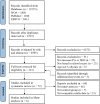Correlates of physical activity and sedentary behavior in children and adolescents during school recess: a systematic review and meta-analysis
- PMID: 40770619
- PMCID: PMC12326734
- DOI: 10.1186/s12889-025-23948-x
Correlates of physical activity and sedentary behavior in children and adolescents during school recess: a systematic review and meta-analysis
Abstract
Background: Physical activity (PA) and sedentary behavior (SED) during school recess in children and adolescents are associated with numerous factors, such as age, gender, and adult engagement. Identifying these correlates can inform the design of recess programs and interventions in schools, while also providing evidence to support the establishment of future recess-related policies. Therefore, this study aimed to identify the correlates of PA and SED in children and adolescents during school recess.
Methods: A systematic search was conducted for studies published in PubMed, EBSCO, and Web of Science from May 2011 to December 2024. We conducted three rounds of literature screening, including removing duplicates, screening titles and abstracts, and full-text screening. This study followed the PRISMA guidelines. The risk of bias was assessed using the Cochrane risk of bias tool. The effect of interventions on PA and SED was assessed by random effects meta-analysis. Identified factors were categorized using the social ecological model.
Results: 72 studies were included in this systematic review. Multiple factors, including age, gender, Body Mass Index (BMI), family economic status, length and frequency of school recess, structured recess, provision of exercise equipment, and playground markings, have been identified as being positively associated with PA among children and adolescents during school recess. Gender factors are also associated with SED. The meta-analysis included 6 studies. Overall results indicated that interventions implemented during school recess had an impact on Light PA (SMD = 0.53; 95% CI = 0.14, 0.93; I²=83%), Moderate PA (SMD = 0.38; 95% CI = 0.16, 0.60; I²=25%), Vigorous PA (SMD = 0.26; 95% CI = 0.09, 0.44; I²=0%), and Moderate-to-Vigorous PA (SMD = 0.49; 95% CI = 0.09, 0.88; I²=86%) in children and adolescents. However, there was no statistically significant effect of the intervention on SED (SMD=-0.54; 95% CI=-1.15, -0.06; I²=91%) (P > 0.05).
Conclusion: This review identified several individual, social, physical environment, and organizational and policy level factors that correlate with PA among children and adolescents during school recess. However, it found a correlation only between gender at the individual level and SED. Therefore, future research should focus more on the relationship between social, physical environment, and organizational and policy level factors and SED among children and adolescents during school recess.
Keywords: Children and adolescents; Correlates; Physical activity; School recess; Sedentary behavior.
© 2025. The Author(s).
Conflict of interest statement
Declarations. Ethics approval and consent to participate: Not applicable. Consent for publication: Not applicable. Competing interests: The authors declare no competing interests.
Figures
References
-
- Trudeau F, Laurencelle L, Shephard RJ. Tracking of physical activity from childhood to adulthood. Med Sci Sports Exerc. 2004;36(11):1937–43. - PubMed
-
- Ridgers ND, Salmon J, Parrish A-M, Stanley RM, Okely AD. Physical activity during school recess: a systematic review. Am J Prev Med. 2012;43(3):320–8. - PubMed
Publication types
MeSH terms
Grants and funding
LinkOut - more resources
Full Text Sources
Medical


